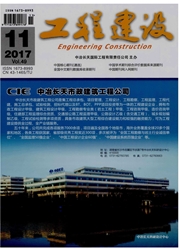

 中文摘要:
中文摘要:
层间位移角是钢筋混凝土框架结构抗震设计的性能指标,进行性能化抗震设计研究具有重要的理论和实践价值.综述了国内外规范对钢筋混凝土框架结构对性能目标的规定以及相关试验研究成果,建立了在不同性能水平时的量化指标.阐述了基于位移角的抗震性能评估方法,通过阻尼比折减法和R折减系数法,给出两个能力谱的实现路径,引用SAP2000完成了算例验算.研究表明:钢筋混凝土框架结构层间屈服最大位移角为1/300~1/150,顶点位移角为1/400~1/200;层间极限最大位移角为1/50~1/30,顶点极限位移角为1/100~1/50.阻尼比折减法和R折减系数法获得性能点基本一致,Vidic-Fajfar-Fischinger折减系数法比阻尼比折减法的计算结果略小,两种方法均可作为性能化抗震设计的实用技术.
 英文摘要:
英文摘要:
Interlayer displacement angle is the seismic design performance index of reinforced concrete frame structure. Performance-based seismic design research has an important theo- retical and practical value. The rule of norms at home and abroad and relevant test results of performance goals are reviewed in this paper. The quantitative indicators of different per- formance levels of frame structure are set up, and expound the seismic performance evalua- tion method based on displacement angle. Through damping ratio subtraction and R reduc- tion factor method, the path of realization of the two power spectrum is given, and the nu- merical example calculation by SAP2000 is completed. Research shows that. The layer yield maximum displacement angle of reinforced concrete frame structure between 1/300-1/150, vertex displacement angle is 1/400-1/200; limit of maximum displacement angle between the layers is 1/50-1/30, vertex limit displacement angle is 1/100-1/50. The fold subtrac- tion and damping ratio R reduction factor method to obtain performance points are basically identical. The subtraction results of Vidic- Fajfar-Fischinger reduction factor method is smal- ler than the damping ratio reduction method, both two methods can be used as a practical technology of the performance-based seismic design.
 同期刊论文项目
同期刊论文项目
 同项目期刊论文
同项目期刊论文
 期刊信息
期刊信息
